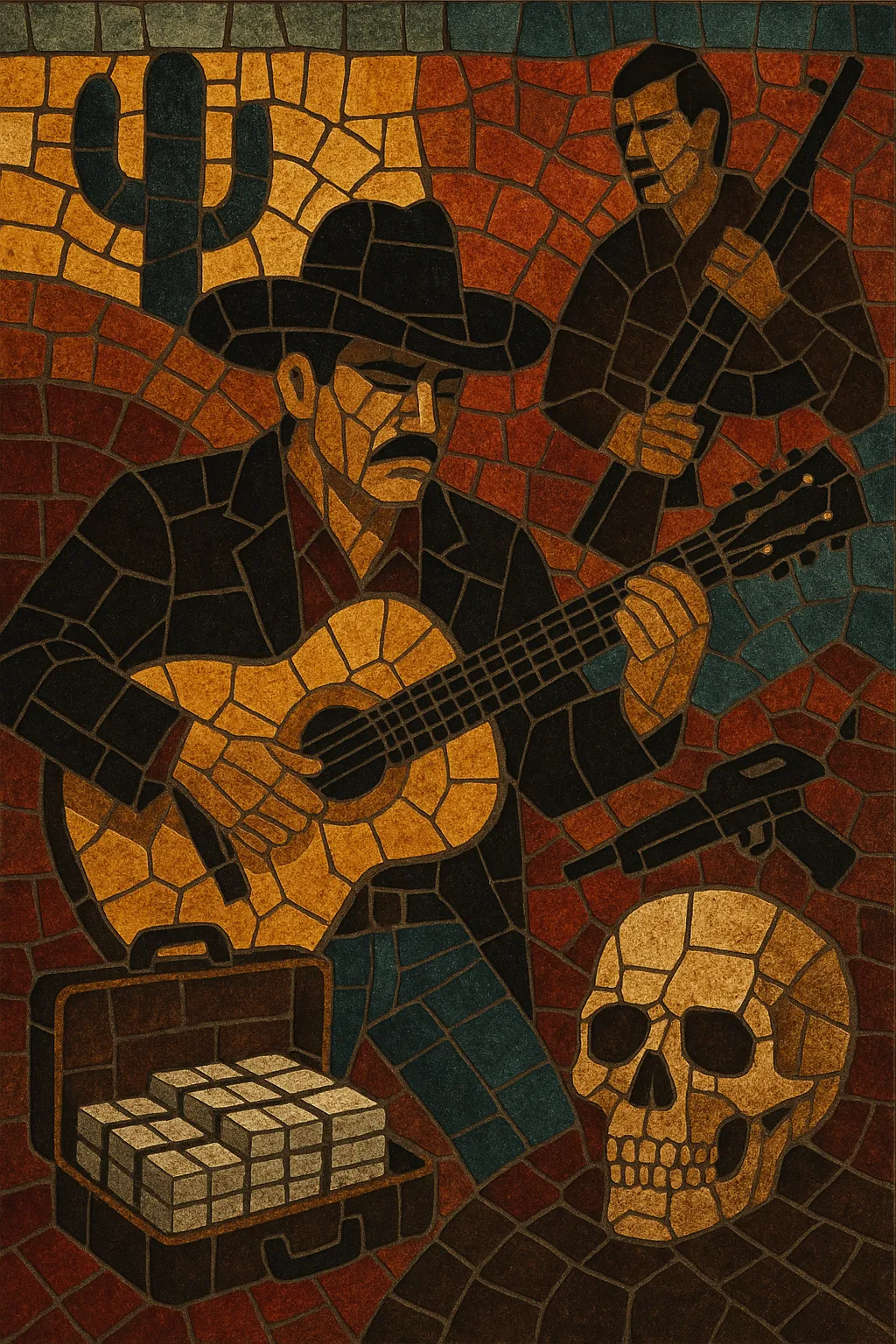Narcocorrido is a modern, narco-themed offshoot of the traditional Mexican corrido, a narrative ballad form that chronicles real or imagined events.
It focuses on the drug trade and its actors—smugglers, cartel leaders, gunmen, and law enforcement—often naming places, dates, and specific episodes to heighten realism.
Musically, it follows the corrido’s strophic storytelling over norteño or banda frameworks: brisk 2/4 polka or 3/4 waltz grooves, diatonic harmonies, and memorable vocal refrains. Typical instrumentation includes accordion and bajo sexto in norteño settings, or tuba, clarinets, trombones, and tambora in banda settings, with sierreño (12‑string guitar plus tuba) variants also common.
The genre is culturally influential yet controversial, facing periodic bans and public debate due to perceived glorification of crime and depictions of violence.
Corrido traditions in Mexico date to the 19th century, but smuggling- and contraband-themed songs along the U.S.–Mexico border began appearing in the early-to-mid 20th century. These ballads laid the narrative blueprint—names, places, and moral dilemmas—that narcocorridos would later adopt and intensify.
The modern narcocorrido coalesced in the 1970s as drug-trafficking networks expanded, especially in northwestern states such as Sinaloa. Norteño groups popularized fast, polka-driven corridos recounting the exploits of traffickers. Los Tigres del Norte’s breakthrough repertoire helped move the topic from local bailes and cassette culture to mainstream awareness, even as radio play remained uneven due to content.
In the 1990s, cassette circulation, dance halls, and regional radio consolidated the style’s audience. The era produced iconic figures like Chalino Sánchez, whose stark storytelling and aura of danger turned him into a folk hero. Increasing media scrutiny and local bans in Mexico and parts of the U.S. heightened the music’s notoriety while also fueling demand.
The 2000s saw tuba-heavy banda and sierreño arrangements become common delivery vehicles, with some labels and collectives foregrounding more explicit, cinematic, and militarized narratives. Videos and DVDs amplified imagery, while news coverage of cartel violence kept the songs topical. Artists faced both fame and real-world risk, and municipal restrictions on performance intensified.
YouTube and streaming platforms globalized the genre, connecting diaspora audiences and spawning new substyles. Corridos tumbados blended trap aesthetics with corrido guitar forms, while corridos bélicos adopted overtly militaristic themes and imagery. Despite ongoing debates over ethics and legality, narcocorridos remain a central current within regional mexicano, evolving in sound while maintaining the core corrido narrative frame.
Choose a norteño or banda palette. For norteño, use accordion, bajo sexto (or 12‑string guitar), electric/standup bass, and snare-driven drums. For banda, center the tuba, clarinets, trombones, trumpets, and tambora; consider sierreño textures (requinto/12‑string plus tuba) for a leaner, guitar-forward feel.
Use a brisk 2/4 polka (two‑step) or a 3/4 waltz. Tempos commonly sit around 90–130 BPM (polka) or 60–90 BPM (waltz). Keep harmony diatonic and functional, relying on I–IV–V progressions in bright major keys (e.g., G, A) with occasional relative‑minor turns. Cadences should support strophic, verse‑led storytelling.
Write a clear, singable vocal line with room for call‑and‑response or instrumental hooks (accordion riffs, tuba motifs, requinto fills). Use strophic verses with refrains; many corridos include a saludo (introductory greeting) and despedida (closing farewell) framing the narrative.
Adopt a reporter’s eye: specify names (or aliases), routes, locales, vehicles, dates, and outcomes. Balance perspective—first‑person confession, third‑person chronicle, or an omniscient narrator. Tone can be cautionary, boastful, or elegiac, but avoid gratuitous incitement; focus on storytelling, consequence, and character. Rhyme and meter should be tight and conversational.
Keep vocals upfront and intelligible; articulate diction is vital. In banda, emphasize the tuba and snare clarity; in norteño/sierreño, highlight the accordion or requinto hook. Use modest reverbs to preserve immediacy. Live, maintain driving two‑step or waltz grooves to keep dancers engaged while the narrative unfolds.
Be mindful of legal and ethical implications when referencing real figures or ongoing events. Consider fictionalization or composite characters, and avoid content that could endanger performers, subjects, or audiences.


